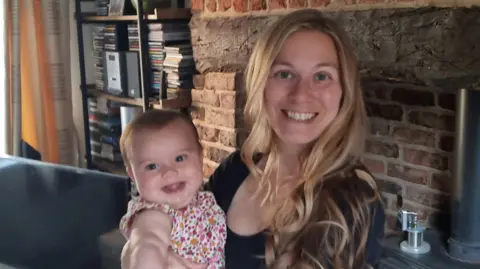 Rebecca Middleton
Rebecca MiddletonWhen Rebecca Middleton became pregnant, she had no idea that she would have to spend the last three months before giving birth in a wheelchair.
Rebecca had a difficult first trimester of pregnancy with nausea and nausea, and began experiencing pelvic pain during her fourth month of pregnancy.
“I could barely walk, I always had problems with lower back pain. But nothing special, and they escalated quite quickly,” she says.
After complaining of pain, she was referred to an NHS physiotherapist and was eventually diagnosed with extreme pelvic girdle pain (PGP), also known as symphysis pubis dysfunction.
Pelvic joint problems are a common symptom of pregnancy, affecting one in five mothers-to-be to one degree or another.
“I was terrified, will I ever be able to walk again? How can I give birth to a child, how will I take care of him?”
 Rebecca Middleton
Rebecca MiddletonAfter giving birth, Rebecca felt less pain, but still struggled with simple things like walking, lifting her son, or pushing a stroller.
“I was disabled for seven months and always needed someone to help me,” she says.
“I just couldn't do what I should be able to do while looking after a child, it was a really difficult time.”
Rebecca was unaware of the problem before becoming pregnant and, based on her experience, she volunteers with The Pelvic Partnership, a charity that helps raise awareness and support women with the condition.
It states that the condition is treatable with the right actions.
Ask for help
As soon as you develop symptoms, the charity advises you get personalized hands-on treatment, including manual therapy, and ask for a referral to NHS physiotherapy from your GP or midwife.
If you are not initially offered this support, the charity suggests returning to your GP or midwife and asking for a second opinion.
They may also be able to refer you to maternal mental health services to help you cope with the emotional impact of living with PGP.
Dr. Nighat Arif, a women's health specialist, says greater awareness and early assessment can prevent patients like Rebecca from having to use wheelchairs or crutches.
“Without this early identification based on a really good understanding of women's bodies, we will leave some of these women with lifelong negative consequences,” she says.
 Victoria Roberton
Victoria RobertonVictoria Roberton, coordinator of the Pelvic Partnership, is an example of how awareness can help.
Like Rebecca, she didn't know what PGP was when she started having the condition during her first pregnancy.
She tried to stay as active as possible as advised and was referred to NHS physiotherapy sessions online and over the phone, but found the pain was getting worse as her pregnancy progressed.
“They gave us exercises, stretches. At this point I couldn't do any of them. It was too painful,” she says.
It got to the point where Victoria felt uncomfortable even sitting, and she almost didn’t go home until the baby was born.
The pain subsided after the birth of her daughter, but she began experiencing the same problem when she became pregnant with her second child.
For many mothers this is not an option, but Victoria said that given her medical history, she decided to pay for a private physiotherapist as the wait for a referral from the NHS was long.
The physical therapist provided a complete assessment and hands-on treatment, including joint mobilization, and taught her different ways to move her body to avoid aggravating her hip problems, which helped relieve her pain.
Victoria is still struggling with her PGP today, four years later, but her second pregnancy was much easier to cope with because she understood her condition and how to manage it.
Rebecca's second pregnancy was also a much more positive experience.
This time she knew she was at risk for PGP and was able to treat it throughout her pregnancy before it became debilitating.
She fully recovered from PGP just two months after birth, compared to two years for her first child.
“I'm probably in better shape now than I was before either of my children because I now know what caused my pelvic girdle pain and have had it fully treated and resolved with chiropractic care,” she says.
“It was five years of hell because of the pain I felt due to my lack of knowledge and understanding of the subject.”









